Toshiba L6453-32, L6453-47, L6453-42 User Manual

USER MANUAL
L64** Digital Series
Register your TV online at www.toshiba.co.uk/registration

English
Contents |
|
INSTALLING YOUR TV |
|
Safety Precautions ....................................................... |
4 |
Installation and important information .......................... |
5 |
The remote control ....................................................... |
7 |
Inserting batteries and effective range .................. |
7 |
CONNECTING YOUR TV |
|
Connecting external equipment.................................... |
8 |
Connecting an HDMI® device....................................... |
9 |
To connect an HDMI device.................................. |
9 |
HDMI’s ARC (Audio Return Channel) feature....... |
9 |
Connecting an HDMI CEC Control compatible |
|
device ...................................................................... |
10 |
Connecting a computer .............................................. |
11 |
To connect a PC to the HDMI terminal ............... |
11 |
To connect a PC to the RGB/PC terminal........... |
11 |
Connecting a home network....................................... |
12 |
To connect the TV to a home network - Wired.... |
12 |
To connect the TV to a home network with an |
|
internet connection - Wireless.......................... |
12 |
To connect the TV to the Device with |
|
Intel® WiDi / wireless display............................ |
13 |
Controls and input connections .................................. |
14 |
Switching on........................................................ |
14 |
Using the TV controls and connections............... |
14 |
Using the menu system....................................... |
15 |
SETTING UP YOUR TV |
|
Startup Application ..................................................... |
16 |
Quick Setup......................................................... |
16 |
Ant/Cable (if available) ........................................ |
19 |
Auto Tuning......................................................... |
20 |
ATV Manual Tuning.................................................... |
21 |
Tuning ................................................................. |
21 |
Skip ..................................................................... |
22 |
Sorting positions.................................................. |
23 |
DTV Manual Tuning ................................................... |
23 |
Manual Tuning .................................................... |
23 |
Manual Tuning for DVB-C ................................... |
24 |
Antenna Amplifier................................................ |
24 |
DTV Settings .............................................................. |
24 |
Channels (Antenna/Cable).................................. |
24 |
Standby Channel Update .................................... |
25 |
Location setting ................................................... |
25 |
Analogue switch-off............................................. |
25 |
Data Transfer ...................................................... |
25 |
CONTROLS AND FEATURES |
|
General controls ......................................................... |
26 |
Quick Menu ......................................................... |
26 |
Selecting channels .............................................. |
26 |
The Time Display – analogue only..................... |
27 |
Stereo and Bilingual transmissions ..................... |
27 |
Sound controls ........................................................... |
27 |
Volume controls and sound mute........................ |
27 |
Sound Navi.......................................................... |
27 |
Sound Mode........................................................ |
27 |
Graphic Equaliser ............................................... |
27 |
TruDialog™......................................................... |
27 |
Surround ............................................................. |
28 |
Sound Separation Effect..................................... |
28 |
TruVolume™....................................................... |
28 |
Dynamic Range Control...................................... |
28 |
Balance ............................................................... |
28 |
Dual..................................................................... |
28 |
Audio Level Offset............................................... |
29 |
TV Speakers ....................................................... |
29 |
Headphone Level................................................ |
29 |
Audio Description................................................ |
29 |
Widescreen viewing ................................................... |
30 |
Picture controls .......................................................... |
32 |
Picture Mode....................................................... |
32 |
Reset................................................................... |
32 |
Picture preferences............................................. |
32 |
ColourMaster ...................................................... |
32 |
Base Colour Adjustment ..................................... |
33 |
Colour Temperature............................................ |
33 |
Auto Brightness Sensor ...................................... |
33 |
Active Backlight Control ...................................... |
33 |
Black/White Level ............................................... |
33 |
MPEG NR – Noise Reduction............................. |
34 |
DNR – Digital Noise Reduction........................... |
34 |
Resolution +........................................................ |
34 |
Cinema Mode...................................................... |
34 |
Resetting the advanced picture settings ............. |
34 |
Expert Picture Settings ....................................... |
35 |
Automatic Format (Widescreen) ......................... |
36 |
4:3 Stretch........................................................... |
36 |
Picture Position................................................... |
37 |
Picture still........................................................... |
37 |
HDMI Information Display ................................... |
37 |
Wireless LAN Information .......................................... |
37 |
Setting up the Network............................................... |
39 |
Wireless Setup.................................................... |
39 |
Advanced Network Setup ................................... |
42 |
DNS Setup .......................................................... |
43 |
Network Connection Test.................................... |
43 |
Using the software keyboard .............................. |
44 |
Network Device Setup................................................ |
44 |
Apps Control Profile ............................................ |
44 |
External Record Control...................................... |
45 |
Companion Device Control ................................. |
45 |
Media Renderer Setup........................................ |
45 |
Device Name Setup ............................................ |
46 |
USB HDD Record Function........................................ |
46 |
Setting up the USB HDD for recording ............... |
47 |
To record DTV programmes |
|
(One Touch Recording) ................................... |
47 |
Auto Recording ................................................... |
47 |
How to set recordings via the Programme |
|
Guide ............................................................... |
48 |
To check, edit or delete scheduling |
|
information ....................................................... |
50 |
To view a recorded programme .......................... |
51 |
2

Operations from the My TV Library screen ......... |
51 |
Recording Setup ................................................. |
52 |
Scheduling priority............................................... |
53 |
Using the Smart TV Cloud services ........................... |
54 |
Using Web Browser ............................................ |
54 |
Using Hybrid TV Standard (if available) ..................... |
55 |
Using Intel® WiDi / wireless display............................ |
56 |
Intel® WiDi / wireless display Device Name........ |
56 |
Device List........................................................... |
57 |
Using My Contents ..................................................... |
57 |
Basic operation ................................................... |
58 |
Viewing photo files |
|
(on a media server or USB device) .................. |
59 |
Viewing movie files |
|
(on a media server or USB device) .................. |
61 |
Playing music files |
|
(on a media server or USB device) .................. |
63 |
Other features ............................................................ |
64 |
Panel Lock .......................................................... |
64 |
Blue Screen......................................................... |
64 |
Netflix® ................................................................ |
65 |
The timers .................................................................. |
65 |
My TV Timer List – digital only........................... |
65 |
On Timer ............................................................. |
65 |
Sleep Timer......................................................... |
66 |
Energy Saving Settings .............................................. |
66 |
Automatic Power Down....................................... |
66 |
No Signal Power Down ....................................... |
66 |
Digital on-screen information...................................... |
67 |
Information .......................................................... |
67 |
Using EPG (Electronic Programme Guide) ................ |
68 |
Using Broadcast Guide ....................................... |
68 |
Genre selection/searching .................................. |
68 |
Digital settings – parental control ............................... |
69 |
Parental PIN Setup ............................................. |
69 |
Parental Setup .................................................... |
69 |
Digital settings – Channel Options ............................. |
70 |
Selecting favourite channels ............................... |
70 |
Favourite Channel List ........................................ |
70 |
Skip channels...................................................... |
70 |
Locking channels ................................................ |
70 |
Digital settings – other settings .................................. |
71 |
Subtitles .............................................................. |
71 |
DVB Character Set.............................................. |
71 |
Audio languages ................................................. |
71 |
Common Interface............................................... |
71 |
Stored CICAM PIN .............................................. |
71 |
Software Upgrade and Licences ................................ |
72 |
Searching for New Software ............................... |
72 |
Network Upgrade ................................................ |
72 |
Software Licences............................................... |
72 |
System Information and Reset TV ............................. |
73 |
System Information ............................................. |
73 |
Reset TV ............................................................. |
73 |
PC Settings ................................................................ |
73 |
Horizontal and Vertical Position .......................... |
73 |
Clock Phase........................................................ |
73 |
Sampling Clock ................................................... |
74 |
Reset................................................................... |
74 |
Input selection and AV connections ........................... |
74 |
Input selection..................................................... |
74 |
Labelling video input sources.............................. |
75 |
Digital Audio Output ............................................ |
75 |
Using HDMI CEC Control........................................... |
76 |
Enable HDMI CEC Control ................................. |
76 |
TV Auto Power.................................................... |
76 |
Auto Standby ...................................................... |
77 |
Amplifier Control ................................................. |
77 |
Initial Speaker Setting......................................... |
77 |
HDMI CEC Control input source selection.......... |
77 |
HDMI CEC Control one touch play ..................... |
78 |
HDMI CEC Control system standby.................... |
78 |
Using MHL TV function .............................................. |
78 |
Connecting an MHL-compatible device .............. |
78 |
Operating an MHL-compatible device................. |
78 |
MHL Setup .......................................................... |
78 |
TEXT SERVICES |
|
Text services .............................................................. |
79 |
Selecting modes ................................................. |
79 |
Text information .................................................. |
79 |
Navigating pages using Auto .............................. |
79 |
Navigating pages using LIST .............................. |
79 |
Control buttons.................................................... |
80 |
PROBLEM SOLVING |
|
Questions and Answers .......................................... |
81 |
INFORMATION |
|
Information ................................................................. |
84 |
Licence information .................................................... |
88 |
Specifications and accessories .................................. |
90 |
During the life of your TV firmware updates will be made available to ensure that your TV maintains optimum performance:
If your TV is connected to the internet, firmware will be automatically made available.
If your TV is not connected to the internet, you can download the latest version of firmware from www.toshiba-om.net/firmware.php
*Some features are limited due to local legislation and may not be available in all countries.
English
3

English
INSTALLING YOUR TV
Safety Precautions
This equipment has been designed and manufactured to meet international safety standards but, like any electrical equipment, care must be taken to obtain the best results and for safety to be assured. Please read the points below for your own safety. They are of a general nature, intended to help with all electronic consumer products, and some points may not apply to the goods you have just purchased.
DO be careful with glass panels or stands on equipment. DO use a soft, dry cloth to clean the unit.
DO NOT REMOVE ANY FIXED COVERS AS THIS WILL EXPOSE DANGEROUS AND ‘LIVE’ PARTS.
THE MAINS PLUG IS USED AS THE DISCONNECTING DEVICE AND THEREFORE SHOULD BE READILY OPERABLE.
Air Circulation
Leave more than 10 cm clearance around all the edges when wall mounting the television to allow adequate ventilation. This will prevent overheating and possible damage to the television. Dusty places should also be avoided. For wall mounted positions at least 2.5 cm gap was retained from the wall and the 10 cm was kept clear around all edges of the TV.
Heat Damage
Damage may occur if the television is left in direct sunlight or near a heater. Avoid places subject to extremely high temperatures or humidity. Place in a location where the temperature remains between 5 °C min. and 35 °C max.
Mains Supply
The mains supply required for this equipment is 220-240 V AC 50 Hz. Never connect to a DC supply or any other power source. DO ensure that the television is not standing on the mains lead.
DO NOT cut off the mains plug from this equipment, this incorporates a special Radio Interference Filter, the removal of which will impair its performance.
In the UK, the fuse fitted in the plug is approved by ASTA or BSI to BS1362. It should only be replaced by a correctly rated and approved type and the fuse cover must be refitted.
IF IN DOUBT, PLEASE CONSULT A COMPETENT ELECTRICIAN.
Do
DO read the operating instructions before you attempt to use the equipment.
DO ensure that all electrical connections (including the mains plug, extension leads and inter-connections between pieces of equipment) are properly made and in accordance with the manufacturers’ instructions. Switch off and withdraw the mains plug before making or changing connections.
DO consult your dealer if you are ever in doubt about the installation, operation or safety of your equipment.
WARNING: To prevent injury, this apparatus must be securely attached in accordance with the installation instructions. See page 5.
Do not
DO NOT obstruct the ventilation openings of the equipment with items such as newspapers, tablecloths, curtains, etc. Overheating will cause damage and shorten the life of the equipment.
DO NOT allow electrical equipment to be exposed to dripping or splashing or objects filled with liquids, such as vases, to be placed on the equipment.
DO NOT place hot objects or naked flame sources, such as lighted candles or nightlights on, or close to equipment. High temperatures can melt plastic and lead to fires.
WARNING: To prevent the spread of fire, keep candles or other open flames away from this product at all times.
DO NOT use makeshift stands and NEVER fix legs with wood screws.
DO NOT leave equipment switched on when it is unattended, unless it is specifically stated that it is designed for unattended operation or has a standby mode. Switch off by withdrawing the plug, and make sure your family knows how to do this. Special arrangements may need to be made for people with disabilities.
DO NOT continue to operate the equipment if you are in any doubt about it working normally, or it is damaged in any way – switch off, withdraw the mains plug and consult your dealer.
DO NOT push/pull CI CAM at a tilt to prevent breakdown of COMMON INTERFACE.
WARNING: Excessive sound pressure from earphones or headphones can cause hearing loss.
ABOVE ALL - NEVER let anyone, especially children, push or hit the screen and cabinet back, or push anything into holes, slots or any other openings in the case. These actions will damage screen or internal parts.
NEVER guess or take chances with electrical equipment of any kind - it is better to be safe than sorry.
4
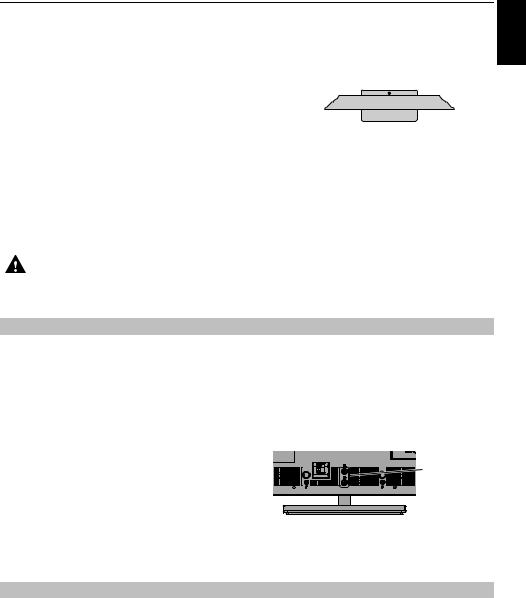
INSTALLING YOUR TV
Installation and important information
Where to install |
|
|
|
|
|
|
|
Locate the television away from direct sunlight and strong |
|
|
|
|
|
|
|
lights. Soft, indirect lighting is recommended for comfortable |
|
|
|
|
|
|
|
|
|
|
|
|
|
|
|
viewing. Use curtains or blinds to prevent direct sunlight |
|
|
|
|
|
|
|
falling on the screen. |
Stand style is dependent on model |
||||||
Place the TV on a stable, level surface that can support
the weight of the TV. In order to prevent injury and maintain stability of this apparatus, it is recommended to secure the TV using the fixings on the stand strap or “P” clips.
The LCD display panels are manufactured using an extremely high level of precision technology; however, sometimes some parts of the screen may be missing picture elements or have luminous spots. This is not a sign of a malfunction.
Make sure the television is located in a position where it cannot be pushed or hit by objects, as pressure will break or damage the screen. Also, please be certain that small items cannot be inserted into slots or openings in the case.
Avoid using chemicals (such as air refreshers, cleaning agents, etc.) on or near the TV pedestal. Studies indicate that plastics may weaken and crack over time from the combination effects of chemical agents and mechanical stress (such as weight of TV). Failure to follow these instructions could
result in serious injury and/or permanent damage to TV and TV pedestal.
When using a Wall Bracket
Use a wall bracket appropriate for the size and weight of the LCD TV.
•Two people are required for installation.
•Install a wall-mount from another manufacturer.
1Unplug and remove any cables and/or other component connectors from the rear of the TV.
2Carefully lay the front of the unit face down on a flat, cushioned surface such as a quilt or blanket.
3Follow the instructions provided with your wall bracket. Before proceeding, make sure the appropriate bracket(s) are attached to the wall and the back of the TV as described in the instructions provided with the wall bracket.
4Always use the screws supplied or recommended by the wall mount manufacturer.
Removing the Pedestal Stand:
1Carefully lay the front of the unit face down on a flat, cushioned surface such as a quilt or blanket. Leave the stand protruding over the edge of the surface.
NOTE: Extreme care should always be used when removing the pedestal stand to avoid damage to the LCD panel.
2Remove the cover and screws.
Screws
3Once you have removed all screws holding the pedestal stand in place, remove the pedestal stand from the TV by sliding the pedestal stand away from the TV.
When using MHL (Mobile High-definition Link)
•Interoperability with MHL devices of other manufacturers is not guaranteed.
•Toshiba does not provide any guarantee, therefore, against operational failure such as that described below when an MHL source is connected to the TV.
-No picture or sound
-Some of the functions do not work by remote operation from the TV
•If the MHL does not work properly, also contact the manufacturer of the source device for advice on its use.
English
5

English
INSTALLING YOUR TV
Please take note
The digital reception function of this television is only effective in the countries listed in the “Country” section of the “Installation” menu. Depending on country/area, some of this television’s functions may not be available. Reception of future additional or modified services can not be guaranteed with this television.
If stationary images generated by 4:3 broadcasts, text services, channel identification logos, computer displays, video games, on-screen menus, etc. are left on the television screen for any length of time, they could become conspicuous. It is always advisable to reduce both the brightness and contrast settings.
Very long, continuous use of the 4:3 picture on a 16:9 screen may result in some retention of the image at the 4:3 outlines. This is not a defect of the LCD TV and is not covered under the manufacturer’s warranty. Regular use of other size modes (e.g. Super Live) will prevent permanent retention.
EXCLUSION CLAUSE
Toshiba shall under no circumstances be liable for loss and/or damage to the product caused by:
i)Fire;
ii)Earthquake;
iii)Accidental damage;
iv)Intentional misuse of the product;
v)Use of the product in improper conditions;
vi)Loss and/or damage caused to the product whilst in the possession of a third party;
vii)Any damage or loss caused as a result of the owner’s failure and/or neglect to follow the instructions set out in the owner’s manual;
viii)Any loss or damage caused directly as a result of misuse or malfunction of the product when used simultaneously with associated equipment;
Furthermore, under no circumstances shall Toshiba be liable for any consequential loss and/or damage including but not limited to the following: loss of profit, interruption of business, the loss of recorded data whether caused during normal operation or misuse of the product.
When Using a USB Hard Drive (HDD)
•The recording function has been designed for private use and entertainment in your home environment. Please note that any commercial use of the recording function could lead to copyright infringement of authors’ rights. Toshiba asks you to respect the intellectual property rights of third parties.
•Before recording to a device connected to the TV, make a test recording and check the recording performance.
•Programmes that are prohibited from copying due to copyright protection cannot be recorded.
•Toshiba shall not be liable for compensation or incidental damages of any kind whatsoever resulting from content that was not properly recorded on the recording device or that was modified or lost.
•Toshiba shall not be liable for damages of any kind whatsoever (breakdown of the recording device, modification or loss of the recorded content, etc.) resulting from malfunction, operating failure or incorrect operation due to combining with another connected device.
•If you connect a USB HDD that has been used with a PC or another TV, only programmes which are recorded using this TV can be playback.
•Switch the TV to standby before you disconnect the USB HDD.
Not doing so may result in loss of the recorded data or malfunction of the USB HDD.
•Please note that recording on the USB HDD is no longer playable after the TV’s main-board is exchanged during service.
•To ensure protection of your personal data Toshiba recommends that you reset all TV settings when you recycle your TV or transfer to others. To reset your TV please access via menu settings, selecting ‘Reset TV’. See owner’s manual page 73 for further details.
6
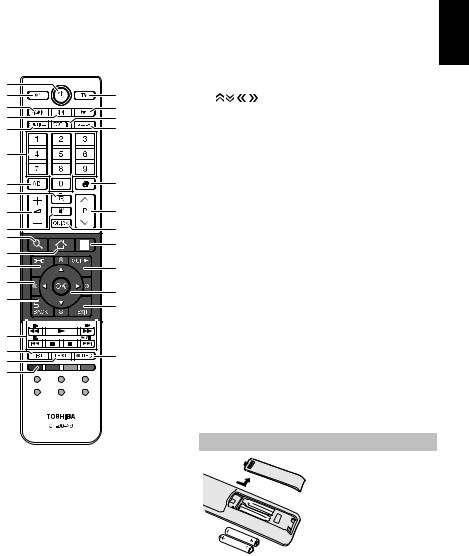
|
|
INSTALLING YOUR TV |
The remote control |
19 |
- Accesses the Smart TV Cloud Home |
|
||
|
20 |
- Accesses to premium content available |
Simple at-a-glance reference of your remote control. |
|
online |
1 |
|
21 |
To access the on-screen Menu |
|
3 |
22 |
To display the digital on-screen Programme Guide |
||
2 |
23 |
|
To page up, down, left or right |
|
4 |
6 |
24 |
When using menus, the arrows move the cursor on the |
|
5 |
8 |
|
screen up, down, left or right. Press OK to confirm your |
|
7 |
9 |
|
selection |
|
10 |
|
25 |
To return to previous Menu |
|
|
26 |
To exit menus and applications |
||
|
|
|||
11 |
12 |
27 |
When in TV mode: |
|
|
D Analogue time display |
|||
13 |
15 |
|
When in Text mode: |
|
14 |
|
A |
To reveal concealed text |
|
16 |
17 |
|
B |
To hold a wanted page |
|
C |
To enlarge text display size |
||
18 |
20 |
|
D To erase Text pages temporarily when you |
|
19 |
|
|
|
are viewing in teletext mode. |
21 |
22 |
|
During Playback: |
|
23 |
24 |
|
c |
To PLAY |
25 |
|
v |
To STOP |
|
26 |
|
W |
To PAUSE |
|
|
|
Z |
To SKIP-BACK |
|
27 |
|
|
CC |
To REWIND |
|
|
cc |
To FAST FORWARD |
|
28 |
30 |
|
z |
To SKIP FORWARD |
|
|
|
||
29 |
28 |
To access the analogue or digital Channel List |
||
31 |
|
29 |
To call up text services |
|
|
|
30 |
To record DTV programmes |
|
|
|
31 |
Colour buttons: Text and interactive service control |
|
|
|
|
buttons |
|
1For On/Standby mode
2To select input sources
3To select TV Mode
4Selectable Picture
5Widescreen viewing
6Picture still
7Digital Subtitles or Analogue TEXT Subtitle pages if available
8sStereo/bilingual transmissions
9To access the sleep timer
10Number buttons
11Switch the Audio Description On/Off
12To return to previous channel
13To display on-screen information
To access the index page in Text mode
14To alter the TV volume
15To change programme positions To change TEXT pages
16To mute the TV sound
17To access Quick Menu
18- Accesses the Search Portal
Inserting batteries and effective range
Remove the back cover to reveal the battery
compartment and make sure the batteries are inserted the proper way. Suitable battery
types for this remote control
are AAA, IEC R03 1.5 V.
Do not combine a used, old
battery with a new one or mix battery types. Remove
exhausted batteries immediately to prevent acid from leaking into the battery compartment. Dispose of them in accordance with instructions on page 89 of this manual.
Warning: Batteries must not be exposed to excessive heat such as sunshine, fire or the like.
The performance of the remote control will deteriorate beyond a distance of five metres or outside an angle of 30 degrees from the centre of the television. If the operating range becomes reduced, the batteries may need replacing.
English
7

English
CONNECTING YOUR TV
Connecting external equipment
Before connecting any external equipment, turn off all main power switches. If there is no switch, remove the mains plug from the wall socket.
ILLUSTRATION SHOWS 32L. |
DVB Common Interface |
|
(for Conditional Access |
|
Module (CAM)) |
|
USB 2 |
|
HDMI 3 (MHL) |
|
HDMI 2 |
|
HDMI 1 (ARC) |
|
Headphones |
SCART (EXT 1) |
USB 1 |
|
HDMI 4 INPUT |
||
COMPONENT VIDEO/AUDIO INPUT |
||
LAN port |
VIDEO/AUDIO INPUT (Y/L/R) (EXT 2) |
|
Aerial |
||
|
DIGITAL AUDIO OUTPUT (OPTICAL)
RGB/PC INPUT 


Aerial Cable
Decoder*
* A Decoder can be digital Satellite, free to air or any other compatible decoder / recorder.
Aerial cables: . . . . . . . . . . . . . . . . . . . . . . . . 



Connect the aerial to the socket on the rear of the TV. If you use a decoder and/or a media recorder, it is essential that the aerial cable is connected through the decoder and/or through the media recorder to the TV.
SCART leads: . . . . . . . . . . . . . . . . . . . . . . . .
Connect the media recorder IN/OUT socket to the television.
Connect the decoder TV socket to the television.
Before running Auto Tuning, put your decoder and media recorder to Standby.
The RCA sockets alongside the COMPONENT VIDEO INPUT sockets will accept L and R audio signals.
When connecting the VIDEO/AUDIO devices, connect those cables to Y/L/R sockets.
The Digital Audio Output socket enables the connection of a suitable surround sound system.
NOTE: This output is always active.
HDMI® (High-Definition Multimedia Interface) is for use with electrical equipment with digital audio and video output. It is designed for best performance with 1080i and 1080p high-definition video signals but will also accept and display VGA, 480i, 480p, 576i, 576p and 720p signals.
PC format signals will also be displayed.
NOTE: Although this television is able to connect to HDMI equipment, it is possible that some equipment may not operate correctly.
LAN port is used to connect the TV to your home network.
A wide variety of external equipment can be connected to the back of the television; therefore, the relevant owner’s manuals for all additional equipment must be referred to for exact instructions.
If the television automatically switches over to monitor external equipment, return to normal television by pressing the desired programme position button. To recall external equipment, press o to select between TV,
EXT 1, EXT 2, HDMI 1, HDMI 2, HDMI 3, HDMI 4 or PC.
When the external input mode is selected while viewing DTV mode, the SCART socket does not output video/ audio signals.
As for SCART output, audio signal may mute or other video signal may output depending on the DTV mode.
8
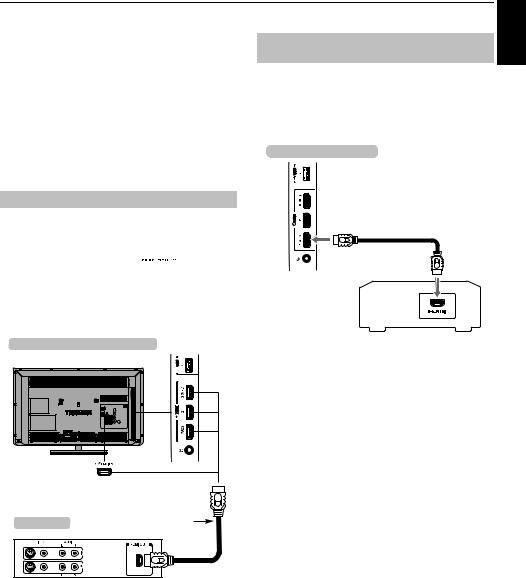
CONNECTING YOUR TV
Connecting an HDMI® device
The HDMI input on your television receives digital audio and uncompressed digital video from an HDMI source device.
This input is designed to accept HDCP (High-Bandwidth Digital Content Protection) programme material in digital form from EIA/CEA-861-D–compliant consumer electronic devices (such as a set-top box or DVD player with HDMI output). For acceptable video signal formats, see page 85.
NOTE: Supported Audio format: Linear PCM, Dolby Digital (AC-3), DTS, sampling rate 32/44.1/48 kHz.
To connect an HDMI device
Connect an HDMI cable (type A connector) to the HDMI terminal.
For proper operation, it is recommended that you use an HDMI cable with the HDMI Logo (

 ).
).
•If your HDMI connection is capable of 1080p and/or your television is capable of refresh rates greater than 50 Hz, you will need a Category 2 cable. Conventional HDMI/ DVI cable may not work properly with this model.
•HDMI cable transfers both video and audio. Separate analogue audio cables are not required (see illustration).
the back and side of your television
ILLUSTRATION SHOWS 32L.
HDMI’s ARC (Audio Return Channel)
feature
This feature enables the audio signal of the TV to be sent to the AV amplifier via the HDMI cable. It will not be necessary to connect a cable from the audio output of the TV to the audio input of the AV amplifier to reproduce the audio received from the tuner of the TV through the AV amplifier.
the side of your television
HDMI cable
AV amplifier that supports ARC
English
HDMI device |
HDMI cable |
To view the HDMI device video, press o to select
HDMI 1, HDMI 2, HDMI 3 or HDMI 4 mode.
9

English
CONNECTING YOUR TV
Connecting an HDMI CEC Control compatible device
You can control the basic functions of connected audio/video devices using the television’s remote control if you connect an HDMI CEC compatible AV amplifier or playback device. For an explanation of setup and operations, see pages 76–78.
the side of your television
ILLUSTRATION SHOWS 32L.
|
|
|
|
|
|
|
|
|
|
|
|
|
|
|
|
|
|
|
|
|
|
|
|
|
|
|
|
|
|
|
|
|
|
|
|
|
|
|
|
|
|
|
|
|
|
|
|
|
|
|
|
|
|
|
|
|
|
|
|
|
|
|
|
|
|
|
|
|
|
|
|
|
|
|
|
|
|
|
|
|
|
|
|
|
|
|
|
|
|
|
|
|
|
|
|
|
|
|
|
|
|
|
|
|
|
|
|
|
|
|
|
|
|
|
|
|
|
|
|
|
|
|
|
|
|
|
|
|
|
|
|
|
|
|
|
|
|
|
|
|
|
|
|
|
|
|
|
|
|
|
|
|
|
|
|
|
|
|
|
|
|
|
|
|
|
|
|
|
|
|
|
|
|
|
|
|
|
|
|
|
|
|
|
|
|
|
|
|
|
|
|
|
|
|
|
|
|
|
|
|
|
|
|
|
|
|
|
|
|
|
|
|
|
|
|
|
|
|
|
|
|
|
|
|
|
|
|
|
|
|
|
|
|
|
|
|
|
|
|
|
|
|
|
|
|
|
|
|
|
|
|
|
|
|
|
|
|
|
|
|
|
|
|
|
|
|
|
|
|
|
|
|
|
|
|
|
|
|
|
|
|
|
|
|
|
|
|
|
|
|
|
|
|
|
|
|
|
|
|
|
|
|
|
|
|
|
|
|
|
|
|
|
|
|
|
|
|
|
|
|
|
|
|
|
|
|
|
|
|
|
|
|
|
|
|
|
|
|
|
|
|
|
|
|
|
|
|
|
|
|
|
|
|
|
|
|
|
|
|
|
|
|
|
|
|
|
|
|
|
|
|
|
|
|
|
|
|
|
|
|
|
|
|
|
|
|
|
|
|
|
|
|
|
|
|
|
|
|
|
|
|
|
|
|
|
|
|
|
|
|
|
|
|
|
|
|
|
|
|
|
|
|
|
|
|
|
|
|
|
|
|
|
|
|
|
|
|
|
|
|
|
|
|
|
|
|
|
|
|
|
|
|
|
|
|
|
|
|
|
|
|
|
|
|
|
|
|
|
|
|
|
|
|
|
|
|
|
|
|
|
|
|
|
|
|
|
|
|
|
|
|
|
|
|
|
|
|
|
|
|
|
|
|
|
|
|
|
|
|
|
|
|
|
|
|
|
|
|
|
|
|
|
|
|
|
|
|
|
|
|
|
|
|
|
|
|
|
|
|
|
|
|
|
|
|
|
|
|
|
|
|
|
|
|
|
|
|
|
|
|
|
|
|
|
|
|
|
|
|
|
|
|
|
|
|
|
|
|
|
|
|
|
|
|
|
|
|
|
|
|
|
|
|
|
|
|
|
|
|
|
|
|
|
|
|
|
|
|
|
|
|
|
|
|
|
|
|
|
|
|
|
|
|
|
|
|
|
|
|
|
|
|
|
|
|
|
|
|
|
|
|
|
|
|
|
|
|
|
|
|
|
|
|
|
|
|
|
|
|
AV amplifier |
|
|
|
|
|
|
|
|
|
|
|
Playback device |
|||||||||||||||||||||||||||||
|
|
|
|
|
|
|
|
|
|
|
|
|
|
|
|
|
|
|
|
|
|
|
|
|
|
|
|
|
|
|
|
|
|
|
|
|
|
|
|
|
|
|
|
|
|
|
|
|
|
|
|
|
|
|
|
|
|
|
|
|
|
|
|
|
|
|
|
|
|
|
|
|
|
|
|
|
|
|
|
|
|
|
|
|
|
|
|
|
|
|
|
|
|
|
|
|
|
|
|
|
|
|
|
|
|
|
|
|
|
|
|
|
|
|
|
|
|
|
|
|
|
|
|
|
|
|
|
|
|
|
|
|
|
|
|
|
|
|
|
|
|
|
|
|
|
|
|
|
|
|
|
|
|
|
|
|
|
|
|
|
|
|
|
|
|
|
|
|
|
|
|
|
|
|
|
|
|
|
|
|
|
|
|
|
|
|
|
|
|
|
|
|
|
|
|
|
|
|
|
|
|
|
|
|
|
|
|
|
|
|
|
|
|
|
|
|
|
|
|
|
|
|
|
|
|
|
|
|
|
|
|
|
|
|
|
|
|
|
|
|
|
|
|
|
|
|
|
|
|
|
|
|
|
|
|
|
|
|
|
|
|
|
|
|
|
|
|
|
|
Playback device
For the setup shown above, you will need three HDMI cables.
NOTE:
•If several devices are connected, the HDMI CEC Control feature may not operate properly.
•For proper operation, it is recommended that you use HDMI cables with the HDMI Logo (


 ).
).
•This function is available when one PC and one AV amplifier are connected separately. However, it may not operate properly if the PC is connected via the AV amplifier.
Before controlling the device(s):
•After completing the above connections, set the HDMI CEC Control Setup menu as you desire (see page 76).
•The connected devices must also be set. For details, see the operation manual for each device.
•The HDMI CEC Control feature uses CEC technology as regulated by the HDMI standard.
•This feature is limited to models incorporating Toshiba’s HDMI CEC Control. However, Toshiba is not liable for those operations. Refer to individual instruction manuals for compatibility information.
10
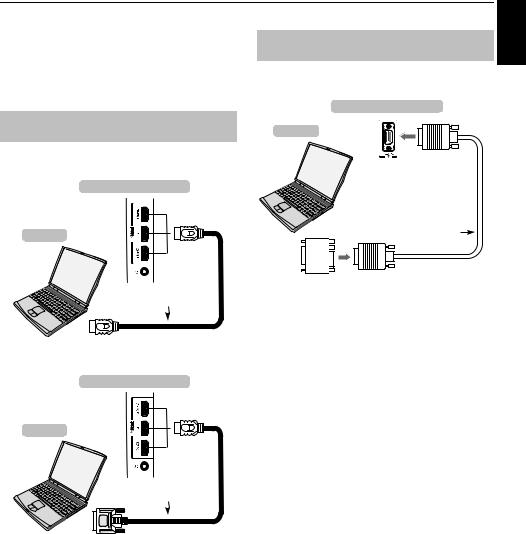
CONNECTING YOUR TV
Connecting a computer
With either an HDMI or an RGB/PC connection, you can watch your computer’s display on the television.
To connect a PC to the RGB/PC terminal
When connecting a PC to the RGB/PC terminal on the television, use an analogue RGB (15-pin) computer cable.
the back of your television
To connect a PC to the HDMI terminal
When connecting a PC to the HDMI terminal on the television, use an HDMI cable (type A connector).
the side of your television
Computer
HDMI cable
If connecting a PC with DVI terminal, use an HDMI-to-DVI adaptor cable.
the side of your television
Computer
HDMI-to-DVI adaptor cable
For acceptable PC and video signal formats, see page 85.
NOTE:
•The edges of the images may be hidden.
•If connecting a certain PC model with a unique PC signal, the PC signal may not be detected correctly.
Computer
Mini D-sub
15 pin connector
RGB PC cable (not supplied)
Conversion adaptor if required (not supplied)
To use a PC, set the monitor output resolution on the PC before connecting it to the television. For acceptable PC signal formats, see page 84.
To display the optimum picture, use the PC setting feature (see page 73).
NOTE:
•Some PC models cannot be connected to this television.
•An adaptor is not needed for computers with a compatible mini D-sub15-pin terminal.
•Depending on the DVD’s title and the specifications of the PC on which you are playing the DVD-Video, some scenes may be skipped or you may not be able to pause during multi-angle scenes.
•A band may appear at the edges of the screen or parts of the picture may be obscured. This is due to scaling of the picture by the set, it is not a malfunction.
•When PC input mode is selected, some of the television’s features will be unavailable e.g. Colour System in the AV connection menu.
•Some PC models may output unique signals that the television may be unable to detect (see page 84).
•If connecting a certain PC model with a unique PC signal, the PC signal may not be detected correctly.
English
11
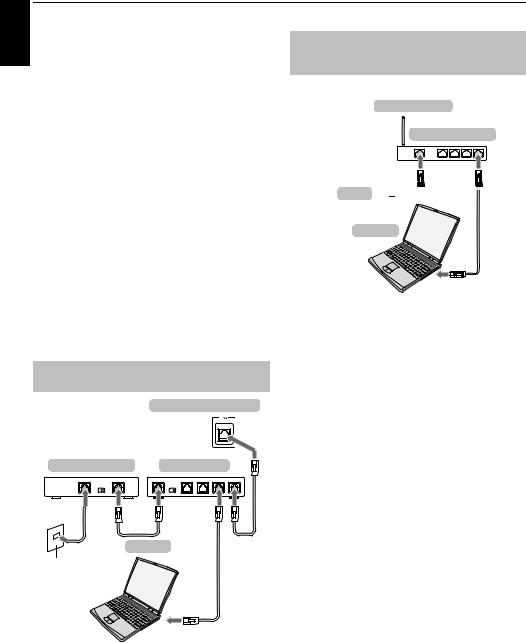
English
CONNECTING YOUR TV
Connecting a home network
The LAN port allows your Toshiba TV to connect to your home network. You can use this revolutionary home entertainment networking system to access photo, video and audio files that are stored on a media server and play/ display them on your TV.
NOTE:
•If you connect to a shared network outside your home, it is advisable to use a router. Always use network media products in private network environments. Connect this TV to the same router as other network media products (server).
•If you use a hub or switch to connect the TV to your home network, you may not be able to use the automatic setup and will have to manually set up the network address. See page 42.
•If you use a router with built-in DHCP functionality, use the automatic setup. Manual setup may not work.
•If you connect the TV and PC directly, use a crossover LAN cable.
•Please consult your PC manufacturer about details of PC settings.
•Wireless appliances may interfere with Intel® WiDi / wireless display.
To connect the TV to a home network - Wired
|
the back of your television |
|
Modem (if available) |
Router with Hub |
|
[1] |
[2] |
|
Server PC |
[2][3] |
|
|
||
Cable or Phone jack |
|
|
[2]
To connect the TV to a home network with an internet connection - Wireless
Please refer to “Wireless Setup” section on page 39.
Access point (AP)
Wireless LAN router
Modem 

Computer
NOTE:
•If this device is going to be operated in the frequency range of 5.15 GHz to 5.35 GHz, it is restricted to indoor use.
•If this device is going to be operated for 802.11 b/g/n function in the frequency range of 2.454 GHz to 2.4835 GHz in France, it is restricted to indoor use.
•A general authorization is required for using this device outdoors or in public places in Italy.
•This device is NOT ALLOWED to be used in the geographical area within a radius of 20 km from the centre of Ny-Alesund in Norway.
•Make the wireless LAN appropriate security setting at the time of wireless LAN use to prevent the illegal use, spoofing and interception of communications.
•Don’t connect wireless LAN to an outside network directly.
Apply the wireless LAN access point with router function or broadband router. Make the router appropriate security setting to prevent the illegal use.
Refer to the manual of router for a security setting.
[1]Coaxial or telephone cable (depending on your modem type)
[2]Standard LAN cable
[3]Do not connect a phone jack directly to the TV’s LAN port.
Warning: This TV complies with the EMC directive only when you use a shielded Cat5 ethernet cable.
12
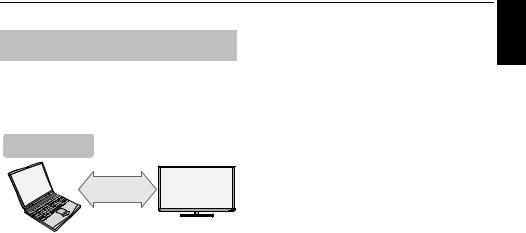
To connect the TV to the Device with Intel® WiDi / wireless display
Available wireless channel is restricted in the following range in case that you use the Intel® WiDi / wireless display.
2.4 GHz: 1~11 ch
5 GHz: 36~48 ch
PC with Intel® WiDi / wireless display
Intel® WiDi
/ wireless display
CONNECTING YOUR TV
English
13
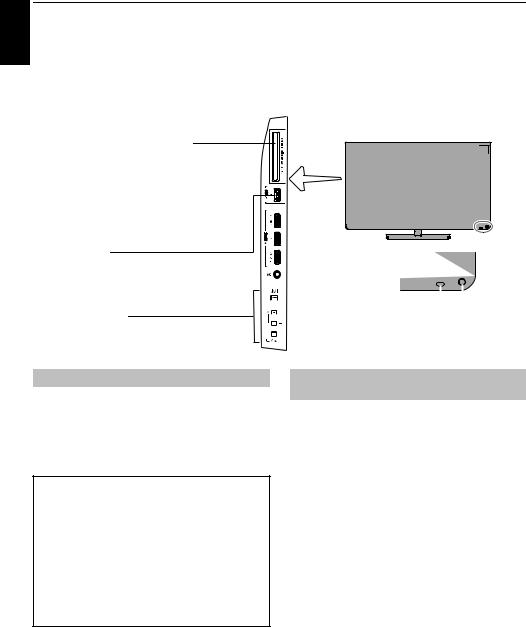
English
CONNECTING YOUR TV
Controls and input connections
A wide variety of external equipment can be connected to the input sockets on the side of the television.
While all the necessary adjustments and controls for the television are made using the remote control, the buttons on the television may be used for some functions.
DVB COMMON INTERFACE
The Common Interface is for a Conditional Access Module (CAM). Contact a service provider.
The software updating of CI Plus CAM may be automatically executed. At this time, your Recording/Reminder programming will be cancelled.
USB port
My Contents/USB HDD connection port
Control panel
ILLUSTRATION SHOWS 32L.
|
|
|
|
|
|
|
|
|
|
|
|
|
|
|
|
|
|
|
|
|
|
|
|
|
|
|
|
|
|
|
|
|
|
|
|
|
|
|
|
|
|
|
|
|
|
|
|
|
|
|
|
|
|
Light sensor |
|
|
|
|
|
|
|
|
|
|
|
|
|
|
|
||
|
|
|
|
|
|
|
|
|
|
|
|
|
|
|
|||
|
|
|
|
|
|
|
|
|
|
|
|
|
|
|
|||
|
|
|
|
|
|
|
|
|
|
|
|
|
|||||
|
|
|
|
|
|
|
|
|
|
|
|
||||||
|
|
|
|
|
|
|
|
|
|
|
|
|
|||||
Remote sensor |
|
|
|
|
|
Power LED |
|||||||||||
|
|
|
|
|
|
|
|
|
|
|
|
On = Green |
|||||
|
|
|
|
|
|
|
|
|
|
|
|
Standby = Red |
|||||
Switching on
If the RED LED is not lit, check that the mains plug is connected to the power supply and press 1on the remote control; it may take a few moments. The GREEN LED will be lit.
To put the television into Standby, press 1 on the remote control. To view the television, press 1again. The picture may take a few seconds to appear.
For energy saving:
We recommend that you use the television with the factory settings. The factory settings are for energy saving.
Unplugging the mains plug will cut energy use to zero for all televisions. This is recommended when the television is not being used for a long time, e.g. when on holiday. Reducing the brightness of the screen will reduce energy use.
Energy efficiency cuts energy consumption and can save money.
NOTE: Putting the television into Standby will reduce energy consumption, but will still draw some power.
Using the TV controls and connections
•To turn on or off the TV, press !.
•To alter the volume, press + or –.
+ and – buttons operate as volume up/down as default.
•Press p / o repeatedly to switch the function of 2 +/
– button as below.
Channel→Input→Volume
The My Contents feature provides access to photo, movie and music files stored on a USB storage device that is connected via the USB 1 or USB 2 port or on a network device.
Please always refer to the owner’s manual of the equipment to be connected for full details.
NOTE:
•The USB socket has limited functionality and Toshiba can take no responsibility for damage to other connected equipment.
•Interactive video games that involve shooting a “gun” at an on-screen target may not work with this TV.
14

CONNECTING YOUR TV
Using the menu system
Press  on the remote control to display the menu.
on the remote control to display the menu.
The menu appears as a list of seven topics. As each icon is selected by pressing B / b on the remote control, its respective options will appear on the right.
NOTE: The same menu is displayed in DTV (Digital TV) and ATV (Analogue TV) modes; however, where some items are not available in a mode, they will appear greyed out.
Press B / b and OK or c
Picture Mode
Picture Reset
Backlight
Contrast
Brightness
Colour
Tint
Sharpness
Advanced Picture Settings
Expert Picture Settings
Display Settings
Press B / b Press B / b and OK or c
Sound Navi
Sound Mode
Sound
Advanced Sound Settings
Sound Separation Effect
TruVolume
Dynamic Range Control
Balance
Dual
Audio Level Offset
TV Speakers
Headphone Level
Audio Description
Digital Audio Output
Press B / b |
Press B / b and OK or c |
|
|
Recording Setup |
|
Options |
My Contents Setup |
|
|
MHL Setup |
|
|
HDMI CEC Control Setup |
|
|
Hybrid TV Standard |
|
|
Teletext |
|
|
Panel Lock |
|
|
AV Connection |
|
|
Power Management |
|
|
Blue Screen |
|
|
HDMI Information Display |
|
Press B / b |
Press B / b and OK or c |
|
|
Menu Language |
|
Installation |
Country |
|
Location |
||
|
||
|
Channel Tuning |
|
|
DTV Settings |
|
|
Quick Setup |
|
|
Reset TV |
|
Press B / b |
Press B / b and OK or c |
|
|
Network Setup |
|
Network |
Network Device Setup |
|
Smart Apps Setup |
||
|
||
Press B / b |
Press B / b and OK or c |
|
|
On Timer |
|
Timers |
Sleep Timer |
|
|
||
Press B / b |
Press B / b and OK or c |
|
|
Software Licences |
|
Get Help |
Software Upgrade |
|
System Information |
||
|
||
|
Store Demo |
English
15
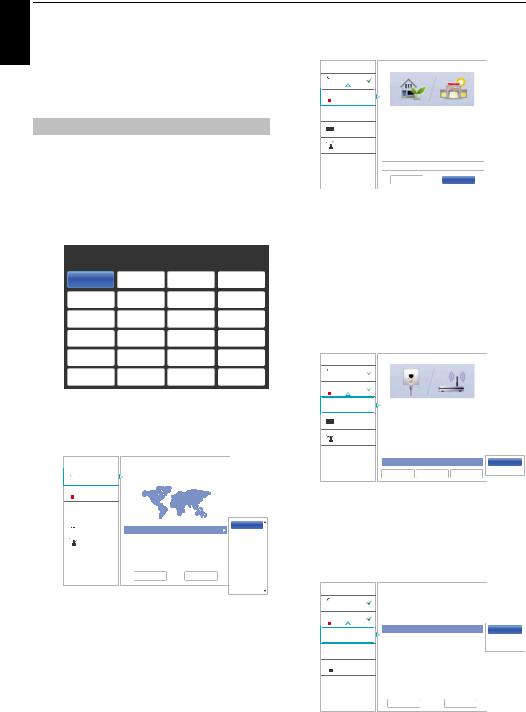
English
SETTING UP YOUR TV
Startup Application
Before switching on the TV make sure that your aerial is connected and any decoder / media recorder, if applicable is connected and in
Standby.
Quick Setup
a Press the 1button, Toshiba logo will appear. After that, The Menu Language screen will appear. This screen will appear the first time that the television is switched on and each time Reset TV is executed.
b Press BbC c to select the menu language and press OK. The Country/Language screen will appear.
Menu Language
Please press [OK] to proceed.
English |
Français |
Deutsch |
Español |
Italiano |
Português |
Nederlands |
Svenska |
Dansk |
Norsk |
Suomi |
Polski |
Türkçe |
Magyar |
Slovensky |
Český |
Pусский |
Română |
Български |
Srpski |
Ελληνικά |
Hrvatski |
Укpaϊнcькa |
Slovenščina |
c Press B / bto highlight Country and press cand B / b to select your country.
The country will be changed, and all existing channels (ATV and DTV) will be cleared even though tuning has not been executed ever.
Quick Setup |
Country/Language |
1/3 |
|
Welcome |
|
Country |
|
|
|
Thank you for choosing Toshiba TV |
|
d Press BbC c to highlight Next and press OK. The Location screen will appear.
Quick Setup
 Country
Country
 Location
Location
Network
Smart TV
Channel Tuning
Location |
1/2 |
To set up the TV for use within a showroom, please select [Store] from the menu below.
[Home] is recommended for normal use.
*Power requirement for Store mode will be higher due to automatic store demos.
 Home
Home
 Store
Store
Previous Next
e Press B / b to select Home or Store and press OK. For normal home use, select Home.
f Press BbC c to highlight Next and press OK. The Auto View screen will appear.
Press C / c to select Yes or No and Press OK.
g Press B / b to select Stand or Wall and press
OK.
Press BbC c to highlight Next and press OK. The Network Type screen will appear.
h Press Bto highlight Network Type and then press c and B / b to select Wireless. Press OK.
Quick Setup
 Country
Country
 Location
Location
Network
Smart TV
Channel Tuning
Network Type |
1/5 |
Network setup allows you to access content on your home network and the Internet. Enjoy online video, music, games, news and more provided by Smart TV portal* and keep your TV up to date with new software.
* Availability is dependant on country selection
Please select from Wired or Wireless
Network Type |
|
Wired |
Wired |
Previous |
Next |
Skip |
Wireless |
|
 Location
Location
 Network
Network
|
|
Smart TV |
|
Country |
Germany |
|
German |
|||
|
|
Primary Subtitle Language |
German |
|
||||||
|
|
|
|
|
Greek |
|
||||
|
|
Channel Tuning |
Secondary Subtitle Language |
Turkish |
|
|
||||
|
|
|
Greenlandic |
|
||||||
|
|
Primary Audio Language |
German |
|
|
|||||
|
|
|
|
|
Hungarian |
|
|
|||
|
|
|
|
|
||||||
|
|
|
|
Secondary Audio Language |
English |
|
||||
|
|
|
|
|
|
|
|
Icelandic |
|
|
|
|
|
|
Previous |
Next |
|
Irish |
|
|
|
|
|
|
|
|
Italian |
|
||||
|
|
|
|
|
|
|
|
|||
|
|
|
|
|
|
|
|
Kurdish |
||
|
|
|
|
|
|
|
|
|
|
|
NOTE:
•The following display menus will differ slightly according to the country you selected.
•If there is not a country that you want to select in the list, select Others.
i j
•When you select Wired (LAN cable connection), skip to step 15.
Press BbC c to highlight Next and press OK. The Wireless Setup screen will appear.
Press B to highlight Wireless Setup and then press c and B / b to select the Wireless Setup type. Press OK.
Quick Setup
 Country
Country
 Location
Location
 Network
Network
 Smart TV
Smart TV
 Channel Tuning
Channel Tuning
Wireless Setup |
2/5 |
Please select a wireless network setup option. Assisted Setup is recommended.
Wireless Setup |
Easy Setup |
|
Easy Setup |
|
|
|
|
Assisted Setup |
|
|
|
|
Manual Setup |
|
|
|
|
|
|
Previous |
Next |
16

|
SETTING UP YOUR TV |
|
There are 3 methods for Wireless Setup: |
- AES, AES/TKIP: 8-63 ASCII or 64 Hex |
|
• Easy Setup - If the AP supports Wi-Fi Protected |
characters |
|
- WEP: 5 or 13 ASCII or 10 or 26 Hex characters |
||
Setup, this method can be used. Wi-Fi Protected |
||
• There is only one key ID to set for WEP |
||
Setup is an industry standard designed to make |
||
connection of wireless LAN equipment and |
encryption. |
|
security setup easy. Wi-Fi Protected Setup will |
Press B / b to highlight Done and press OK. |
|
automatically configure all wireless settings. |
||
|
||
NOTE: WEP or TKIP encryption may not be |
NOTE: |
|
• If Network Name is not displayed, see Manual |
||
able to configured by easy setup. |
||
Setup below to set Network Name before Done |
||
|
||
• Assisted Setup - follow step 12. |
is selected. |
|
Input the Security Key only. |
• If BACK is pressed before Done is selected, |
|
• Manual Setup, skip to step 13. |
settings are not saved. |
|
Input the all settings. |
When the message “Wireless configuration is |
|
|
||
NOTE: EXIT is available during settings. |
complete.” appears on screen, press OK. |
|
k In step 10, when you select Easy Setup; |
The screen will skip to step 14. |
|
m In step 10, when you select Manual Setup; |
||
Press BbC c to highlight Next and press OK. |
||
|
The Easy Setup screen will appear.
Press c and B / b to select PBC (Push Button Configuration) or PIN (Personal Identification Number) and press OK.
Press b to highlight Start Scan and press OK.
PBC - Following the on-screen instructions, push the appropriate button on your AP. When a window reporting that the setup is complete appears, press
Press BbC c to highlight Next and press OK. The Manual Setup screen will appear. Press B / b to select Network Name and press OK.
The Software Keyboard window will appear (page 44).
Input the Network Name by using the Software Keyboard. To save your setting, press the GREEN button.
OK.
PIN - When the PIN code window appears, enter the displayed PIN into your AP, and then press OK to continue the PIN Setup. When a message displays to report that the setup is complete, press
OK.
To cancel searching for the AP:
Press BACK while searching for the AP. A message will appear, and then press C / cto select Yes and press OK.
l In step 10, when you select Assisted Setup;
Press BbC c to highlight Next and press OK. The Assisted Setup screen will appear.
Press B / b to select the desired AP and press
OK.
NOTE: Check the MAC address on the label of the AP or in the manual, and select your AP.
Press B / bto select Security Key and press OK. The Software Keyboard window will appear (page 44).
Input the Security Key by using the Software Keyboard. To save your setting, press the GREEN button.
NOTE:
•The Security Key must adhere to these conditions:
Press B / b to select Authentication and then press c and B / b to select Open System,
Shared Key, WPA2/WPA-PSK (mixed mode WPA2/WPA) or WPA2-PSK. Press OK.
Press B / bto select Encryption, and then press c and B / b to select None, WEP, AES/TKIP or AES. Press OK.
NOTE:
•Certain encryption types are only compatible with specific authentication types.
-When Authentication is Open System, only WEP or None is compatible.
-When Authentication is Shared Key, only WEP or None is compatible.
-When Authentication is WPA2/WPA-PSK (mixed mode WPA2/WPA), only AES/TKIP is compatible.
-When Authentication is WPA2-PSK, only AES is compatible.
•When incompatible Authentication/Encryption pairings are detected, a warning message will be displayed, and no connection attempt will be made until the incompatibility is resolved.
•There is only one key ID to set for WEP encryption.
Press B / bto select Security Key and press OK. Input the Security Key by using the Software Keyboard (page 44).
English
17
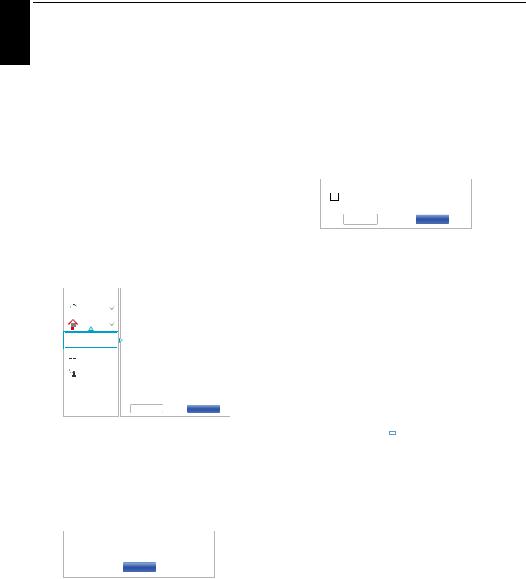
English
SETTING UP YOUR TV
To save your setting, press the GREEN button. This item is greyed out when Encryption is None.
When Encryption is WEP, Key ID setting is available. Press B / b to select Key ID and press c and B / b to select 1 (default), 2, 3 or 4.
Press B / b to highlight Done and press OK. When the message “Wireless configuration is complete.” appears on screen, press OK.
NOTE: Settings are not saved if BACK is pressed before Done is selected.
n The Advanced Network Setup screen will appear.
When the DHCP function of the router connected with this TV is On, you can set Auto Setup to On or Off. (This should usually be set to On.)
When the DHCP function of the router is Off, set Auto Setup to Off, and set the IP Address DNS address(es) manually.
Quick Setup |
Advanced Network Setup |
3/5 |
||||
|
|
Country |
|
|
|
|
|
Auto Setup |
|
On |
|||
|
|
|
|
|
||
|
|
|
|
|
|
|
|
|
Location |
|
IP Address |
xxx . xxx . xx . x |
|
|
|
|
|
Subnet Mask |
xxx . xxx . xx . x |
|
|
|
Network |
|
|||
|
|
|
Default Gateway |
xxx . xxx . xx . x |
||
|
|
|
|
Auto Setup |
|
On |
|
|
Smart TV |
|
|
||
|
|
|
Primary DNS Address |
xxx . xxx . xx . x |
||
|
|
|
|
|||
|
|
Channel Tuning |
|
Secondary DNS Address |
xxx . xxx . xx . x |
|
|
|
|
|
Previous |
|
Next |
|
|
|
|
|
||
You can view the fixed MAC address for the TV, if one is installed.
Press B / b to highlight Next.
o Press OK, and Network Connection Test will start.
A message will appear to indicate if the connection was successful or if could not be completed.
Network Connection Test |
5/5 |
Network connection was completed successfully.
OK
NOTE: The result of Network Connection Test does not always guarantee the connection.
To cancel the Network Connection Test:
Press EXIT while testing.
When the network can be accessed, Software Upgrade starts automatically. When Software Upgrade is completed, proceed to the next step.
p Press OK, and Power Management screen will appear. Press B / b to highlight the External Record Control. Press c and B / b to select Off or On and press OK.
q Press B / b to highlight the Companion Device Control. Press c and B / b to select Off or On and highlight Next.
r Press OK. If the Ant/Cable screen appears, press B / bto select Antenna or Cable, and then press OK to check ( ).
).
 Antenna
Antenna
Cable
Previous |
Next |
s Press BbC c to highlight Next and press OK. The Auto Tuning start up screen will appear with the option to select between DTV and ATV, DTV or ATV if available. Press c and B / b to select the appropriate mode and press OK.
T Press b to highlight Start Scan, and press OK.
The television will start to search for available DTV and/or ATV channels. The progress bar will indicate the scan status.
You must allow the television to complete the search.
Auto Tuning - Antenna |
|
||
|
Progress |
Found |
|
DTV Tune |
4 % |
|
0 |
ATV Tune |
Waiting... |
|
0 |
|
|||
|
Channel: 23 |
|
|
|
|
|
|
When the search is complete, the television will automatically select channel one.
The Auto Tuning screen will display the total number of services found.
u Press C / c to view the DTV (digital channel) or ATV (analogue channel) lists.
18

SETTING UP YOUR TV
v Press B / b to move through the list to select a channel, and then press OK to view.
In ATV mode, some areas may receive duplicate stations. There may not be a clear picture or the signal may be weak, so the station order can be changed using ATV Manual Tuning.
REMEMBER: Press TV at any time to select between ATV and DTV modes.
NOTE: The time will be set automatically by transmission but can be advanced or decreased by using Local Time Setting in the DTV Settings screen.
PLEASE NOTE
The Quick Setup menu can also be accessed at any time from the Installation menu.
Ant/Cable (if available)
From this menu, you can set the RF input configuration.
a Press |
and B / b to highlight Installation |
icon. |
|
b Press cand B / bto select Channel Tuning and press OK.
c Press B / b to select Ant/Cable and press OK. d Press B / b to select Antenna or Cable.
e Press B / b to highlight Next and press OK.
NOTE: When you attempt to change the Ant/ Cable setting, a warning message will appear followed by PIN entry (if PIN has been set) and a prompt for Auto Tuning.
f When Ant/Cable is set to Cable, the following setting options will be provided in the Auto Tuning screen.
Press B / bto select an item and press cand B / b to select your desired option.
Auto Tuning - Cable |
|
|
|
|
Tuning Mode |
DTV and ATV |
|
|
|
Start Scan |
|
|
DTV |
|
|
|
Operator Selection |
Others |
|
|
Scan Type |
Quick Scan |
|
|
Start Frequency |
Auto |
|
|
End Frequency |
Auto |
|
|
Modulation |
Auto |
|
|
Symbol Rate |
Auto |
|
|
Network ID |
Auto |
|
With the exception of DTV Scan Type and DTV Modulation items, all of the following items will have 2 operating modes. The first is Auto where the values for each item are preset by the system. The second is an Input mode where you will be able to enter a single value in place of the pre-set value. If no channel is currently tuned and the Input state is chosen, a system default value will be shown. However, if a channel is currently tuned when the item is accessed, the value of the current channel will be displayed.
English
19

English
SETTING UP YOUR TV
Operator Selection: Auto Tuning
You can choose the Cable operator depending on the
Country you set. NOTE: As new services are broadcast, it will be necessary to re-tune the television in order to view them.
DTV Scan Type:
This item determines whether a Quick Scan or a Full Scan will be executed.
The Quick Scan is a simplified version of the Full Scan that is designed to complete in less time.
DTV Start Frequency:
This sets the frequency from which the scan will begin.
DTV End Frequency:
This sets the frequency at which the scan will end.
DTV Modulation:
You can choose from six QAM modulation settings.
DTV Symbol Rate:
This is the baud rate (KS/s) of the scan.
Auto Tuning will completely re-tune the television and can be used to update the channel list. It is recommended that Auto Tuning is run periodically to ensure that all new services are added. All current channels and settings, i.e. locked channels, will be lost.
a Press |
and B / b to highlight Installation |
icon. |
|
b Press cand B / bto select Channel Tuning and press OK.
c Press B / bto select Auto Tuning and press OK.
< Channel Tuning
Ant/Cable
Auto Tuning
ATV Manual Tuning
DTV Manual Tuning
Antenna Amplifier
DTV Network ID:
This is the Network ID to be utilized for the scan. This item is greyed out when DTV Scan Type is set to “Full Scan”.
A message will appear, and then press C / c to select Yes and press OK.
d Press c and B / b to select DTV, ATV or DTV and ATV, if available, then highlight Start Scan and press OK to continue with the Auto Tuning.
Auto Tuning - Antenna
|
|
|
|
|
Tuning Mode |
DTV |
|
DTV |
|
|
|
|
ATV |
|
|
|
|
DTV and ATV |
|
|
|
|
|
|
|
Start Scan |
|||
NOTE: If you have selected Others for the
Country field in the Installation menu, and selected a tuning mode other than DTV, choose the optimum ATV broadcasting system (B/G, I, D/ K or L).
The television will start to search for all available DTV and/or ATV services.
You must allow the television to complete the search.
When the search is complete, the Auto Tuning screen will display the services found.
e Press B / b to move through the list to select a channel and press OK to view.
20
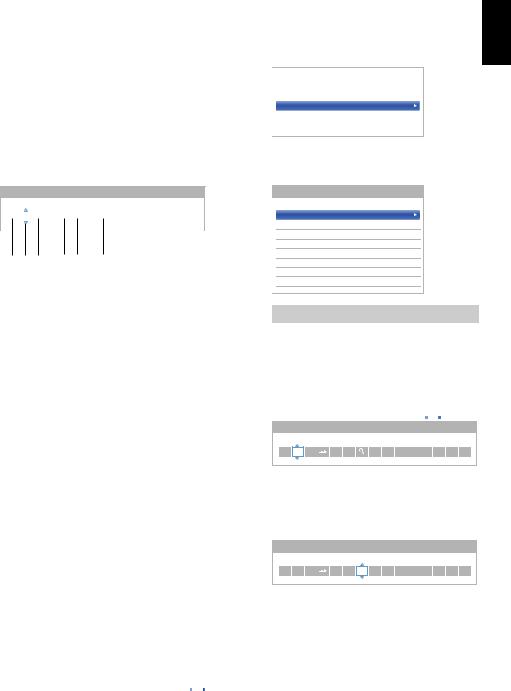
|
|
SETTING UP YOUR TV |
|||
ATV Manual Tuning |
a In the Channel Tuning menu, press b to select |
||||
|
ATV Manual Tuning and press OK. |
||||
|
|
|
|
|
|
Tuning |
< Channel Tuning |
||||
The television can be tuned-in manually using ATV |
|
Ant/Cable |
|
|
|
|
Auto Tuning |
|
|
||
Manual Tuning. For example, you might use the feature |
|
ATV Manual Tuning |
|||
if the television cannot be connected to a media recorder/ |
|
DTV Manual Tuning |
|||
decoder with a SCART lead or when you want to tune-in a |
|
Antenna Amplifier |
|
||
station on another System. |
|
|
|
|
|
Use C / cto move across the screen and select any of the |
b Press B / b to select the desired position. We |
||||
ATV Manual Tuning options. Then use B / bto adjust the |
suggest Pos. 0 for a media recorder. |
||||
settings. |
|||||
|
|
|
|
||
ATV Manual Tuning
System
|
1 |
|
I |
A |
|
|
|
|
C |
|
2 |
|
|
|
|
0 |
|
V |
|
C |
|
R |
|
|
|
|
|
|
|
|
|
|
|
|
|
|
|
|
|
|
|
|
|
|
|
|
|
|
|
|
|
|
|
|
|
|
|
|
|
|
|
|
|
|
|
|
|
|
|
|
|
|
|
|
|
|
|
|
|
|
|
|
|
|
|
|
|
|
|
|
|
|
|
|
|
|
|
|
1 2 3 4 5 6 7 8 9
1Position
The number to be pressed on the remote control to tune the channel.
2System
Specific to certain areas.
3Colour System
Factory set to Auto, should only be changed if problems are experienced, i.e. NTSC input from external source.
4Skip
Set Skip to On (8) or Off (() for the selected channel. See page 22.
5Signal Class
The channel classification.
6Channel
The channel number on which a station is being broadcast.
7Search
Search up and down for a signal.
8Manual Fine Tuning
Only used if interference/weak signal is experienced. See page 81.
9Station
Station identification. Use the Bb and C cbuttons to enter up to seven characters.
To allocate a position on the television for a decoder and media recorder: turn the decoder on, insert a pre-recorded film in the media recorder, press PLAY and manually tune.
ATV Manual Tuning
Pos. |
Channel |
Station |
0 C2
1S10
2C7
3S40
4C22
5C25
6C28
7C30
Different Channel numbers may be displayed.
c Press OK to select. If the channel chosen for the media recorder is set to skip, Skip should be removed before storing.
d Press c to select System and press B / b to change if required.
ATV Manual Tuning |
|
|
System |
|
|
1 I A |
C 2 |
0 |
e Then press c to select Search.
f Press B / b to begin the search. The search symbol will flash.
ATV Manual Tuning |
|
|
Search |
|
|
1 I A |
C 2 |
0 |
English
21
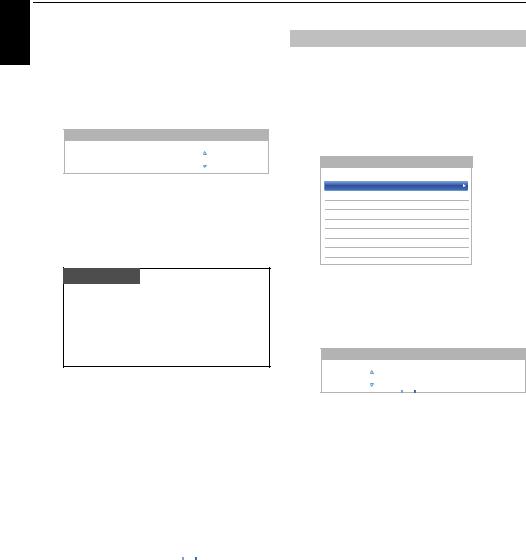
English
SETTING UP YOUR TV
g Each signal will show on the television. If it is not your media recorder, press B / b again to restart the search.
h When your media recorder signal is found, press c to move along to Station. Use BbC c to put in the required characters, e.g. VCR.
ATV Manual Tuning
Station
1 |
|
I |
|
A |
|
|
|
C |
|
2 |
|
|
|
0 |
|
V |
|
C |
|
R |
|
|
|
|
|
|
|
i Press OK to save.
j Repeat for each position you want to tune. k Press EXIT when you have finished.
PLEASE NOTE
This television has direct channel entry if the channel numbers are known.
Select the ATV Manual Tuning screen in Step 3. Enter the Position number, the System, then
C for standard (terrestrial) channels or S for cable channels and the Channel number. Press OK to save.
Skip
To prevent certain channels from being viewed, positions can be skipped.
a Select ATV Manual Tuning from the Channel Tuning menu.
b Press B / bto highlight the position to be skipped and press OK.
ATV Manual Tuning
Pos. |
Channel |
Station |
0 C2
1S10
2C7
3S40
4C22
5C25
6C28
7C30
c Press c to select Skip.
d Press B / b to turn Skip on and press OK.
8 on the screen indicates a skipped position.
ATV Manual Tuning
Skip: On
1 |
|
I |
|
A |
|
|
C |
|
2 |
|
|
|
0 |
|
|
|
|
|
|
|
|
|
|
|
|
|
|
e Press BACK and repeat from Step 2 or press
EXIT.
Each position has to be individually selected. To turn Skip off, repeat the procedure for each position.
Skipped positions cannot be selected by PU and Puor by the controls on the television but can still be accessed by the number buttons on the remote control.
22

SETTING UP YOUR TV
|
DTV Manual Tuning |
Sorting positions |
Channels may be moved and saved to the position of your choice.
a Select ATV Manual Tuning from the Channel Tuning menu.
b With the list of channels showing, press B / b to highlight the position to be moved and press c.
ATV Manual Tuning |
|
|
|
Pos. |
Channel |
Station |
|
0 |
C - 69 |
|
|
|
|
||
1 |
C - 31 |
BBC1 |
|
2 |
C - 43 |
BBC1 |
|
3C - 7
4C - 9
5C - 12
6C - 23
7C - 2
c Press B / b to move through the list to your preferred position. As you do so, the other channels will move to make room.
d Press C to save your move.
Repeat as necessary and press EXIT.
NOTE: This feature varies depending on the Ant/Cable setting.
Manual Tuning
This feature is available for service engineers or can be used for direct channel entry if the multiplex channel is known.
a Select DTV Manual Tuning from the Channel Tuning menu and press OK.
DTV Manual Tuning - Antenna
WEAK AVERAGE STRONG
Signal Strength |
|
|
Quality |
|
|
GOOD |
|
|
Channel |
67 |
|
Frequency |
842.00 MHz |
|
Bandwidth |
8 MHz |
|
Start Scan |
|
|
b Press B / b to select Channel and press c to display the Channel Number list. Use the number buttons to enter the number.
c Press B / b to select Frequency and press C / c to adjust the value. When there is no Channel corresponding to the Frequency, “--” is displayed to the Channel.
d Highlight Start Scan and press OK. The television will automatically search for that multiplex.
DTV Manual Tuning - Antenna
0 New Channels - Total 6
New |
Pos. |
Name |
Type |
||
|
1 |
ABC ONE |
|
|
|
|
|
|
|
||
|
2 |
ABC TWO |
|
|
|
|
|
|
|
||
|
7 |
ABC THREE |
|
|
|
|
|
|
|
||
|
40 |
ABC NEWS 24 |
|
|
|
|
|
|
|
||
|
51 |
ABCi |
|
|
|
|
|
|
|
||
When the multiplex is found, any channels that are not currently in the channel list will be added and the channel information at the top of the screen will be updated.
e Repeat as necessary. Press EXIT to finish.
English
23

English
SETTING UP YOUR TV
Manual Tuning for DVB-C
When Ant/Cable is set to Cable, DTV Manual Tuning items are as follows:
Frequency: Input a specific frequency to be scanned
Modulation: Choose from one of five QAM modulation options
Symbol Rate: Input a specific baud rate (KS/s) to be used for the manual scan
Highlight Start Scan and press OK.
Antenna Amplifier
a Select Antenna Amplifier from the Channel Tuning menu and press OK.
b Press B / b to select DTV and press OK. Press B / b to select On or Off.
c Press B / b to select ATV and press OK. Press B / b to select On or Off.
DTV Settings
Channels (Antenna/Cable)
The channel order may be changed to suit your personal preference.
a Select DTV Settings from the Installation menu and press OK.
b Press B / b to select Channels and press OK.
< DTV Settings
Channels
Subtitle and Audio
Parental PIN Setup
Parental Control
Local Time Setting
DVB Character Set
Standby Channel Update
Dynamic Scan
Data Transfer
Common Interface
Stored CICAM PIN
c For your convenience, you can jump to specific places in the list by one of two methods.
Channels |
Antenna TV |
|
|
Line No. |
1/10 |
|
|
Pos. Name
1ABC ONE
2ABC TWO
7 |
ABC THREE |
30 |
CABC Channel |
40 |
ABC NEWS 24 |
51 |
ABCi |
822AA
823AC
Line Number Jump — Use the number buttons (0-9) to input the line number you want to select and press OK.
It is also possible to change the Position number of a particular channel.
Renumber — Press the RED button to renumber the highlighted channel. Edit the channel number using the number buttons and press OK. If the position number you input already exists, a confirmation window will appear.
Pos. Name
ABC ONE
24

SETTING UP YOUR TV
Move — Press the GREEN button to activate the Move feature. Press B / b to select the channel you wish to move and press OK to check.
If you wish to move multiple channels at once, select another channel and check in the same way. Repeat as necessary.
Once all desired channels have been checked, press B / b to place the focus at the position to which you wish to move the channels. The channels will be inserted above the highlighted channel. Press the GREEN button to execute the move.
Channels |
Antenna TV |
|
|
||||||
|
|
|
Line No. |
1/10 |
|
|
|
||
|
|
|
|
|
Pos. |
Name |
|||
|
|
|
1 |
ABC ONE |
|||||
|
|
||||||||
|
|
|
2 |
ABC TWO |
|||||
|
|
||||||||
|
|
|
|
|
|
|
|
|
|
|
|
|
7 |
ABC THREE |
|||||
|
|
|
|
|
|
|
|
|
|
|
|
|
30 |
CABC Channel |
|||||
|
|
|
|
|
|
|
|
|
|
|
|
|
40 |
ABC NEWS 24 |
|||||
|
|
|
|
|
|
|
|
|
|
|
|
|
51 |
ABCi |
|||||
|
|
|
|
|
|
|
|
|
|
|
|
|
822 |
AA |
|||||
|
|
|
|
|
|
|
|
|
|
|
|
823 |
AC |
||||||
|
|
|
|
|
|
|
|
|
|
Delete — Press the BLUE button to activate the Delete feature. Press B / b to select the channel you wish to delete and press OK. Press the BLUE button and select “Yes” on Confirmation Message to execute the Delete.
Sort — Press the YELLOW button.
A confirmation window message will appear. In the window, if you select Yes, it will transit to “Sort Type Selection” window.
In the “Sort Type Selection” window, there are 3 kinds of sort type.
-Number (default)
-A - Z Sort
-Z - A Sort
Standby Channel Update
If the Standby Channel Update is set to On, when the TV is in Standby, Digital Tuning is automatically executed.
a Select DTV Settings from the Installation menu and press OK.
b Press b to select Standby Channel Update and press c and B / b to select On or Off.
Location setting
You can select either Home or Store mode. Home is recommended for normal home use. Select Store when using the television for displaying in a shop, etc.
a Select Location from the Installation menu.
b Press c or OK to edit Location and press B / b to select Home or Store.
Analogue switch-off
This is a digital television which is integrated to allow the use of both digital and analogue services. However, during the lifetime of this set it is very likely that analogue services will be switched off to allow for more new digital services.
This ‘switch-off’ will happen in a number of phases, which will be advertised in your area well in advance. It is recommended that at each phase the television is retuned to ensure that existing and new digital services can be viewed without disruption.
Data Transfer
You can copy channel information from TV to USB memory and edit the channel information by using your PC and updates channel information to your TV.
continue? |
a Select DTV Settings from the Installation menu |
Your existing channel order will be lost. Do you wish to |
|
Yes |
and press OK. |
|
Renumber, Move, Sort and Delete functions are not available for Antenna channels. Renumber, Move, Sort and Delete functions are available only for the DVB-C in Germany.
b Press B / b to select Data Transfer and press c and B / b to select Channel List, Transponder Table (if available) or Preset Order.
c In case of Channel List and Transponder Table, press cto select USB to TV or TV to USB. In case of Preset Order, select USB to TV.
English
25

English
CONTROLS AND FEATURES
General controls
Quick Menu
Quick Menu helps you access some options quickly, such as Picture Mode, Picture Size, More Information, Sleep Timer etc.
Press QUICK to open the Quick Menu and use B / b to select the option.
Quick Menu |
|
|
|
|
Intel® WiDi / wireless display |
|
|
|
Picture Mode |
Standard |
|
|
Picture Size |
Wide |
|
|
More Information |
|
|
|
Channel Options |
|
|
|
Sleep Timer |
|
|
|
HDMI CEC Device Control |
|
|
|
Speakers |
TV Speakers |
|
|
Headphone Level |
30 |
|
|
Wireless Information |
|
|
|
My TV Library |
|
|
|
Recording Information |
|
|
NOTE: Quick Menu items are different depending on the current mode.
Quick menu item example
Mode |
Quick menu item |
Description |
|
When viewing a TV |
Intel® WiDi / wireless |
See page 56. |
|
programme or |
display |
|
|
pictures from the |
Picture Mode |
See page 32. |
|
external input |
|
|
|
Picture Size |
See page 30. |
||
Single Window |
|||
More Information |
See page 67. |
||
|
|||
|
Channel Options |
See page 70. |
|
|
Sleep Timer |
See page 66. |
|
|
HDMI CEC Device |
See page 76. |
|
|
Control |
|
|
|
Speakers |
See page 77. |
|
|
Headphone Level |
See page 29. |
|
|
Wireless Information |
See page 41. |
|
|
My TV library |
See page 51. |
|
|
Recording |
See page 67. |
|
|
Information |
|
|
When using EPG |
Genre Colour |
See page 68. |
|
|
EPG Update / Cancel |
See page 68. |
|
|
EPG Update |
|
|
My Contents |
Picture |
See page 32. |
|
|
Sound |
See page 27. |
|
|
Interval Time |
See page 60. |
|
|
Repeat |
See page 60. |
|
|
Device Information |
See page 59. |
|
|
Background Music |
See page 60. |
|
|
Play List |
See page 60. |
|
|
Sleep Timer |
See page 66. |
|
|
Speakers |
See page 77. |
|
|
Headphone Level |
See page 29. |
|
|
Wireless Information |
See page 59. |
Selecting channels
To select a channel, use the numbered buttons on the remote control.
Channels can also be selected using PU and Pu.
To display on-screen information such as channel, input mode or stereo/mono signal, press  . Press again to cancel.
. Press again to cancel.
26

CONTROLS AND FEATURES
The Time Display – analogue only
The time display facility allows the current (text service) time to be seen on the television screen.
Press Dwhilst watching a normal television broadcast to see the time display from the broadcaster. It will remain on screen for about 5 seconds.
NOTE: This display may not be available in some cases.
Sound controls
Volume controls and sound mute
Volume
Press 2+ or 2– to adjust the volume.
Sound Mute
Press  once to turn the sound off and again to cancel.
once to turn the sound off and again to cancel.
Stereo and Bilingual transmissions
For DTV programmes
For stereo or dual mono broadcasts, press sand use C / c to select settings.
Mode Display |
Pressing c |
Stereo |
Stereo S Left S Right |
|
|
Dual mono |
Dual 1 S Dual 2 |
|
|
Mono |
– |
|
|
Multichannel |
– |
|
|
For multi-audio track broadcasts, press srepeatedly to change the audio language (see “Audio languages” on page 71).
For ATV programmes
If stereo or dual language broadcasts are transmitted, the word Stereo or Dual will appear on the screen each time channels are changed, disappearing after a few seconds. If the broadcast is not in stereo, the word Mono will appear.
Stereo… Press sto select Stereo or Mono.
Bilingual… Bilingual transmissions are rare. If they are transmitted, the word Dual will be displayed. Choose the required programme number, and if the word Dual appears, press sto select Dual 1, Dual 2 or Mono.
Sound Navi
To set the frequency characteristics in the equaliser function corresponding to the environment.
a Press |
and B / b to highlight Sound icon. |
b Press cand B / bto select Sound Navi to select
Stand or Wall.
Sound Mode
This feature adjusts the Advanced Sound Setting depend on the content.
a In the Sound menu, press B / b to select Sound Mode and press cand B / b to select Standard,
Music, Movie, Clear Voice or Sound Separation and press OK.
Graphic Equaliser
This feature adjusts the frequency of output. This feature is effective only the selection of Standard in Sound Mode.
a In the Advanced Sound Settings menu, press
B/ bto select Graphic Equaliser and press OK. Graphic Equaliser screen will be displayed. Press
C/ c to select frequency and press B / b to select level. To close the window, press EXIT.
TruDialog™
Dialog enhancement for clear and intelligible vocals.
a In the Advanced Sound Settings menu, press
B / bto select TruDialog and press cand B / b to select On or Off.
English
27

English
CONTROLS AND FEATURES
Surround
This feature is effective only the selection of Standard in
Sound Mode.
a In the Advanced Sound Settings menu, press
B / bto select Surround and press cand B / b to select Off, TruSurround or Depth Rendering.
TruSurround: High quality surround sound and expanded sound field over two speakers.
Depth Rendering: Near and far depth sound field for a greater sense of immersion.
Sound Separation Effect
When the note box appears, press OK to enable Sound Separation. When activated, this feature allows you to emphasize either the dialogue or the background sound. You can do so by adjusting the value on the slider bar. The closer the value is to the  position, the more the
position, the more the
dialogue is emphasized and the lower the background sound level.
a In the Sound menu, press B / b to select Sound Separation Effect and press OK. The selection bar will be displayed.
Press C / c to select value.
NOTE:
•This setting is temporary. When you switch the TV to standby, or change the channel or external input, the value is restored to the previous setting.
•Sound Separation has been designed for private use and entertainment in your home environment. Please note that any unlawful use, including public and/or commercial use, could lead to copyright infringement of the holder's rights. Toshiba asks you to respect the intellectual property rights of third parties.
•The effect of Sound Separation depends on the content used.
•If the content is mono, there may be little effect.
•Sound Separation may amplify the noise that is included in the content.
•The volume may wobble when you enable Sound Separation.
•Sound Separation takes a few seconds to exert after enabling it, changing content and changing volume.
•Sound Separation may not work with some applications.
TruVolume™
Consistent volume, despite volume spikes or changes in content sources.
When TV Speaker is On, you can set TruVolume to On or Off.
a In the Sound menu, press B / b to select
TruVolume.
b Press c and B / b to select On or Off.
Dynamic Range Control
This feature allows control of audio compression for some digital TV programmes (MPEG-1 and MPEG-2 audio programmes are not supported).
a In the Sound menu, press B / b to select
Dynamic Range Control.
b Press c and B / b to select On or Off.
Balance
a In the Sound menu, press B / b to select Balance and press C / c to emphasize left and right speaker balance.
Dual
If a programme or film is being broadcast with a soundtrack in more than one language, the Dual feature allows selection between them.
a Press  and B / b to highlight Sound icon.
and B / b to highlight Sound icon.
b Press cand B / bto select Dual and press cand B / b to choose between Dual 1 or Dual 2.
< Sound |
|
Sound Navi |
Stand |
Sound Mode |
Standard |
Advanced Sound Settings |
|
Sound Separation Effect |
1 |
TruVolume |
Off |
Dynamic Range Control |
On |
Balance |
0 |
Dual |
Dual 1 |
Audio Level Offset |
|
TV Speakers |
On |
Headphone Level |
|
|
|
Audio Description |
|
28
